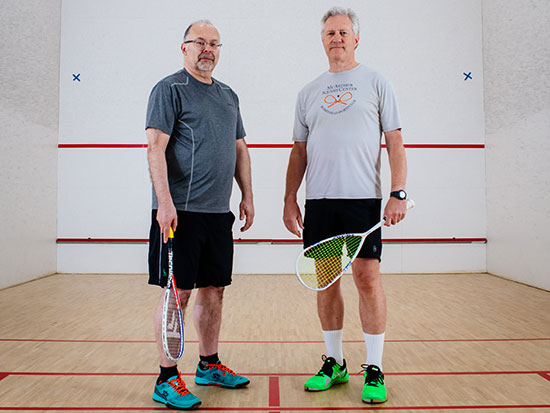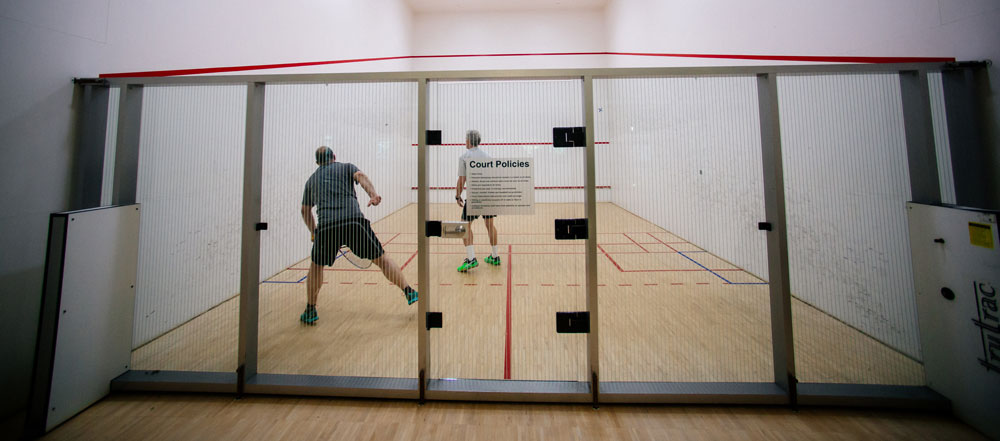 Microbiologist Peter Prevelige, Ph.D. (left) and biomedical engineer Allan Dobbins, Ph.D. (right) are two of the squash regulars at the Rec Center's courts. STEVE WOOD | University RelationsBetween July 10 and 17, elite racquetball and squash players from around the world will converge on UAB’s Rec Center for men’s and women’s singles competition. To maximize viewing angles, the athletes will play on four glass-walled courts specially constructed in Center Court, the facility’s largest space.
Microbiologist Peter Prevelige, Ph.D. (left) and biomedical engineer Allan Dobbins, Ph.D. (right) are two of the squash regulars at the Rec Center's courts. STEVE WOOD | University RelationsBetween July 10 and 17, elite racquetball and squash players from around the world will converge on UAB’s Rec Center for men’s and women’s singles competition. To maximize viewing angles, the athletes will play on four glass-walled courts specially constructed in Center Court, the facility’s largest space.
Professor Peter Prevelige, Ph.D., a microbiologist specializing in virus assembly, has tickets for every event in the squash competition (July 14-17; purchase tickets here). “What people will see at The World Games will blow them away,” said Prevelige, who has been playing squash on campus for 25 years. “There is no way to capture the speed and athleticism on TV — you have to see it in person.” Squash is a game of extended rallies. At the professional level, the action may continue unbroken for several minutes straight, Prevelige says. (Televised tournaments include live heart-rate telemetry from the athletes, to illustrate how close they are to maximum output.)
The game is a great workout for anyone, Prevelige adds; but the strategy and shot techniques are what keep him hooked. “The pros are thinking at least three or four shots ahead,” he said. “The game is all about moving your opponent out of the ‘T,’ the center of the court, so you are aiming to hit along the walls and in the corners. You are constantly working to refine ball placement.”
 In the photo above, Dobbins stands in the "T," the most advantageous position on the squash court. Note the tin, the lowest line on the front wall. Balls hit on or below the tin are out, so the tin acts like the net in tennis. STEVE WOOD | University Relations
In the photo above, Dobbins stands in the "T," the most advantageous position on the squash court. Note the tin, the lowest line on the front wall. Balls hit on or below the tin are out, so the tin acts like the net in tennis. STEVE WOOD | University Relations
Try Campus Rec for free
All UAB employees are eligible for a one-week free trial to the Campus Recreation Center. Learn more.
Prevelige is one of a core group of roughly a dozen squash aficionados on campus who meet a few afternoons a week to play on the Rec Center’s squash court. Their number includes Allan Dobbins, Ph.D., a professor in the Department of Biomedical Engineering; Warner Huh, M.D., chair of the Department of Obstetrics and Gynecology; and Dan Berkowitz, M.D., chair of the Department of Anesthesiology, along with UAB alumni and members of the Birmingham squash community. In addition to regular games, organized through a texting chain, they travel to play in tournaments in Atlanta and Chattanooga.
Prevelige is eager to see the squash scene expand in Birmingham and at UAB and is counting on the exposure from The World Games to inspire spectators to give it a try. “We are very interested in growing the game,” he said. “I would be glad to talk with anyone who wants to learn more.”
Story continues below video.
Racquetball at noon gang
UAB’s racquetball regulars also hope that the elite World Games matches (July 10-13; tickets here) could drive spectators to the Rec Center’s permanent courts, which are only steps away from the competition site. “It’s great that UAB will be hosting these events, and it would be wonderful if it got people interested,” said David Schwebel, Ph.D., University Professor of Psychology and associate vice president for Research Facilities and Infrastructure. Schwebel is a longstanding member of RANG — the racquetball at noon gang — which has been meeting daily at the Rec Center and its predecessor gym facility for more than three decades. (A plaque outside Racquetball Court 1 commemorates RANG founding member Bruce Wheatley, Ph.D., professor of anthropology, who died in 2018, and dates the group’s origins to “circa 1987.”)
Story continues below video.
Schwebel was a competitive tennis player in high school before moving on to squash as an undergraduate and badminton in graduate school, then got an introduction to racquetball during his clinical training in Seattle. When he came to UAB in the early 2000s, the racquetball courts were “right across the street” in what is now known as the Physical Education Building. “I found fellow racquetball players and started developing my game in yet another racquet sport,” he said. Schwebel used to play in the evenings, but “after my kids were born, evening games got complicated schedule-wise,” and he joined the RANG group.
Today, RANG includes faculty, staff and alumni who Schwebel describes as “an eclectic group of rather talented players.” Although their numbers are still rebounding from the COVID-enforced shutdown at the Rec Center, “games start at 11:30 almost every weekday,” he said. Depending on numbers, they play singles, doubles or a three-person game called “cutthroat.” Throats are not actually cut, but any game of racquetball is sure to be a workout. “The ball moves fast, and the sport is played fast,” Schwebel said. “You are mixing endurance and strength, hitting the ball hard and running; but there is also touch and art involved. After an hour, I am walking out of there knowing that I’ve had some great exercise.”
Squash and racquetball compared
Superficially similar, the two sports are perhaps best differentiated by looking at the ball and the lines. A racquetball is quite elastic, somewhere between a tennis ball and a superball, bounce-wise, and somewhat smaller than a tennis ball. A squash ball is smaller than a golf ball and, at room temperature, has little more natural bounce than a hackysack. In the midst of competition, the squash ball heats up and bounces enough to set the tone for the sport’s lengthy rallies.
One key element of the squash court is the tin line, a strip of metal on the front wall that is set a little more than a foot off the floor. It acts like the net in tennis — a ball hit on or below the tin is out. A line 15 feet high on the front wall, which runs diagonally down each side of the court to a point 7 feet high where it meets the back wall, marks the limits of play.
Racquetball, by contrast, is unbounded. All four walls, and the ceiling, are in play. One of the most effective shots, the kill shot, is hit right into the angle where the front wall meets the floor.
